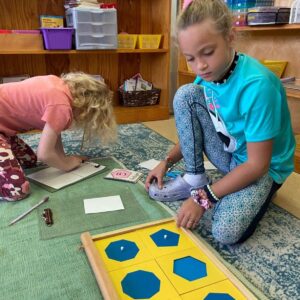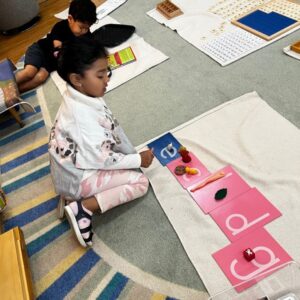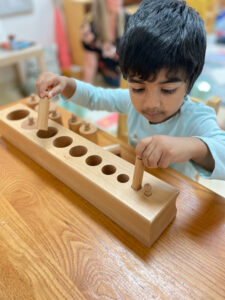The Value of Repetition and Routine

The Value of Repetition and Routine
Why is a strong routine – waking up, getting dressed, eating breakfast, brushing teeth – so crucial for children? Why do Montessori students repeat and practice lessons over and over again? Children must master new developmental skills and lay the groundwork for ordered and structured thinking. It fulfills a basic need for future learning.
Repetition
Many families have asked why circle times and lessons in our Montessori environments often follow the same patterns and routines. Repetition and routine are essential principles in Montessori education. Montessori theory holds that humans love mastery, and we have all heard that “practice makes perfect.” For this reason, children are hardwired to enjoy executing tasks until they fully understand them. This regular repetition of tasks comforts children and offers more significant understanding.
“Growth comes from the repetition of an exercise and not from the first apprehension of something new. When a child has reached the stage where he repeats an exercise, he begins to grow anteriorly, as may be seen from his exterior discipline. But this phenomenon does not always occur. The same exercises are not repeated at every age. Repetition should correspond to a need. The essence of the experimental method of education consists in providing exercises that will satisfy the needs of a growing organism.” – Dr. Maria Montessori, The Discovery of the Child.
Routine and Sense of Order
Along with the need for repetition, routine and order are also crucial to children’s development. Children need order and often work to find patterns and classification systems within their environments. Once they master the sense of order, they can move on to new lessons, allowing for more confident cognitive and academic growth.
How can we satisfy a child’s need for order?
Maintain predictable routines. Your child’s wake-up, get-ready, and breakfast routines should follow the same steps whenever possible. In the spirit of Montessori, making space for children to do things for themselves is also a plus. Remember that it is less important to follow specific times than the flow of activities.
Be on time for school. We observe that children at school before 8:30 have the most straightforward transition into the day. They have enough time to put their things away, receive daily announcements, greet friends and teachers, and begin work. When children arrive late, their friends and teachers are already engaged with work and other students. The child starts the day feeling out of sync with their class and has to work to find those patterns within their daily environment.
The same thing goes for dinner time and bedtime. Those routines are comforting to children and help them feel safe and secure.
It is important to remember that your child is looking to you as a role model. Expressing emotions and prioritizing self-care are excellent examples for your child to see from you. Your behavior is one of the biggest influences on your child’s current and future behaviors, and your routines will impact their choices.
“A child who has become master of his acts through long and repeated exercises, and who has been encouraged by the pleasant and interesting activities in which he has been engaged, is a child filled with health and joy and remarkable for his calmness and discipline. -Dr. Maria Montessori, The Discovery of the Child







